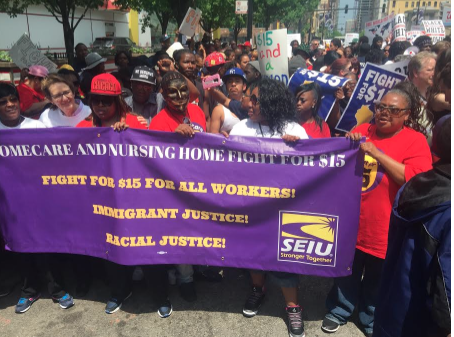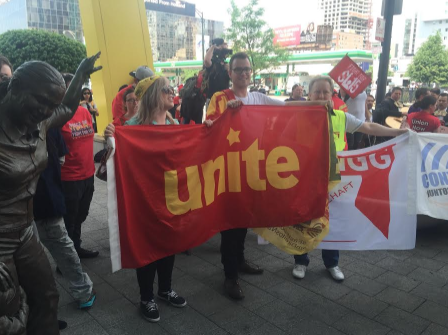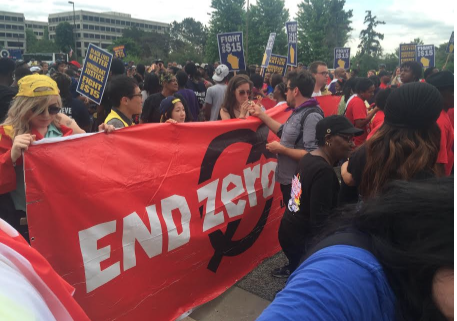
Re-elected SEIU President Mary Kay Henry is second from left holding banner displaying themes of the recent SEIU convention outside McDonald’s protest in Chicago following the convention.
The US labour movement and US politics more generally are undergoing a profound transformation. Titanic battles are brewing, between the working class majority and the one percent, and between radicalising political forces on the right and left. The future of life on the planet may well hang on how this battle is resolved.
I had the privilege of seeing a bit of this up close as a guest of the 1.8 million-strong Service Employees International Union which has been a key player in two aspects of this process – the campaign led by fast food workers for $15 and a union, and the fight in the Democratic Party over whether Bernie Sanders or Hillary Clinton was to be the party’s nominee for president in this year’s election. Clinton herself spoke at the convention of the SEIU I attended May 20 – 24 as a representative of Unite Union alongside Unite President and McDonald’s delegate Victoria Hopgood and Unite exec member and McDonald’s delegate Alastair Reith. Following the convention, we also had the pleasure to join two days of protests outside the McDonald’s national headquarters in Chicago where the annual shareholders meeting was scheduled.
US politics has been dominated by two-party system virtually since the foundation of the republic. Both parties, the Republicans and the Democrats, have served the interests of the wealthy rulers of the time. The labour movement has never developed an independent voice of the working class beyond relatively marginal votes for socialist of communist candidates that never exceeded a million votes in a presidential election.
Since the 1930s New Deal policies under the hugely popular Democratic Party president Franklin D. Roosevelt, the trade union leaderships in the US have been tied to the leadership of this party. Roosevelt won four elections in a row serving between March 4, 1933 – April 12, 1945, when he died just four months into his fourth term. Roosevelt’s breaking of an unwritten rule to only serve two terms led to a constitutional amendment to make this rule official.
For a foreign observer, the common reactionary foreign policies of these two parties seemed to mean there was little difference between them from this period. Progressive political leaders of third world countries had as much chance being invaded and killed under a Democrat as they did a Republican. The Vietnam War was prosecuted by both sides with the same imperial ruthlessness.
Domestic policies also seemed to differ little, except that the legacy of the New Deal policies to combat the recession and prosecute World War Two, continued to be identified with the Democrats. This included public works programmes to combat unemployment and some modest social insurance measures that provided basic income support.
By the 1990s, even this difference seemed to disappear. The presidency of Hillary Clinton’s husband William was marked by the proclaimed goal of “ending welfare as we know it” and cosying up to Wall Street.
Even US president Obama has been a huge disappointment for those who held out hopes that the election of an intelligent, liberal black man as president would lead to a more progressive policy. Obama has killed a record number of people through illegal drone strikes, he has deported a record number of “illegals” from US soil, the war on drugs and mass incarceration has continued, the bailout of Wall Street was prioritised in the 2008 recession rather than job protection.

Two NZ McDonald’s delegates support their US comrades in protest outside McDonald’s following SEIU convention. Holding Unite banner from left is Victoria Hopgood, Unite President, and Alastair Reith a Unite executive member.
The position of working people in the US has deteriorated under both Republican and Democratic presidencies since the mid-1970s and the end of the post-World war Two period of accelerated economic expansion. The benefits of virtually all growth since then has gone almost exclusively to the one percent. Debt and financial parasitism have exploded while basic industry and manufacturing has relocated to low-wage countries abroad.
As I witnessed first hand this trip to the US, mighty industrial cities like the previous centre of the US auto industry Detroit have been reduced to a wasteland. Wikipedia reports that union density has collapsed: “In 2013 there were 14.5 million members in the U.S., compared with 17.7 million in 1983. In 2013, the percentage of workers belonging to a union in the United States (or total labour union ‘density’) was 11.3%, compared to 20.1% in 1983. From a global perspective, the density in 2010 was 11.4% in the U.S., 18.4% in Germany, 27.5% in Canada, and 70% in Finland. Union membership in the private sector has fallen under 7% — levels not seen since 1932.”
US commentators bemoan the decline of the US middle class – but they actually mean the decline of the US working class. Millions of jobs that were covered by a union contract, with associated higher pay and job security, have been eliminated in recent decades. These have been replaced by what have been dubbed “McJobs” – minimum wage, no job security.
This is the first time in US history that for a generation growing up their status is poorer than their parents.
There is understandably a backlash developing. This is reflected in four very powerful new social movements shaking up US society. These are Fight for $15 and a Union, Black Lives Matter, the fight to legalise 11 million workers without documents, and climate justice.
All four fights were powerfully represented at the 3000-strong national convention of the SEIU. All four issues were seen as intertwined aspects of workers fight for their emancipation. Separate sessions were devoted to each aspect beginning with “Fight for $15 and a Union” what has become the major sustained public campaign or workers to organise the unorganised.
Fight for $15 and a Union was initially launched in November 2012 as a movement of fast food workers with its own identity separate from the SEIU. It had spectacular success as 18 states and Washington DC as well as city after city voted to increase their minimum wages significantly. Reports at the SEIU convention estimated that 23 million workers had benefited from these state and city measure with minimum wages often going from a federal minimum of $7.25 to $15 over the next few years.
Tens of thousands of fast-food and other low-wage workers have joined campaigns. The SEIU has bankrolled this with tens of millions of dollars spent. The SEIU officials have been able to point to the state and city-wide minimum wage changes as proof of the benefit for workers generally, but this has also paid off for many workers on union contracts earning less than $15 an hour.
This campaign has also helped inspire more traditional well-organised sectors of the working class to stand up and fight – and win. This was true for the 40,000 strong Verizon workers strike while we were in the US that ended in victory after six and a half weeks on strike.
Turning that broad public support into ongoing union structures on the ground has proved more elusive but the SEIU convention remained absolutely committed to that task. In fact, the model associated with the fast food workers campaign was being extended to planned future campaigns to unionise large regional employment centres like airports.
The SEIU have also made their fast food campaign an international one. McDonald’s, which is their primary target in the US is giant international company and second largest employer after Walmart. Knocking them over requires a worldwide effort.
That is why Unite Union in New Zealand has been invited to join the campaign. We also bring the benefit of taking on these corporations in this country and winning a union-negotiated collective agreement, a substantial rise in start rates associated with major improvements in the minimum wage, and an end to zero-hour contracts. Having zero hour contracts ultimately outlawed in New Zealand made our colleagues look at us with some respect and a desire to learn as much as possible from each other.
The SEIU has encouraged and supported organising campaigns in the fast food industry in Europe, Asia, Latin America. Regular international meetings are held to coordinate efforts. The International Union of Foodworkers is a central part of the campaign. International days of action involving workers in 40 countries have become a regular feature.
The SEIU has also played an important role in exposing how McDonald’s acts as a tax cheat in Europe. A police raid on McDonald’s HQ in France followed a formal investigation beginning over an estimated tax loss of $US336 million. Public prosecutors in Brazil have begun a probe there over wage theft and tax fraud.
The final aspect of the SEIU convention was its strong support for Hillary Clinton as the Democratic Party nominee for president. This was the one issue that provoked some open dissent from the convention floor with about one-quarter to one-third voting to delete Clinton’s name from formal endorsement in a multi-paragraph resolution supporting the Democratic Party candidates.
Nearly all the major unions in the US strongly supported Clinton. Without their support, it is unlikely she would have won the elected delegates by 60% to 40% over Bernie Sanders. To left-wing observers outside the US, this support seemed odd. Sanders clearly came across as more strongly pro-labour. He supports an increase in the Federal minimum wage to $15 now, not some indeterminate time in the future like Clinton. He stood on workers’ picket lines during the campaign. His programme is traditional social democracy – with free health care and education among his priorities. He was described as a “democratic socialist” and anyone in countries where labour or social democratic parties have existed and governed, we would be familiar with his language and policies.
But in the US Sanders was considered a radical threat to the pro-Wall Street Democratic Party establishment. The establishment had concluded long before the votes were counted in the primary campaign that Sanders was unelectable in the US. His democratic socialist policies were considered “unrealistic” in US political terms. Most national union officials are part of that establishment.
The political landscape in the US has moved to the right over the last few decades. Both major parties have endorsed essentially the same policies. But the Republican Party has increasingly been captured by an even more radical right wing factions that combine aspects of Christian fundamentalism with pro-free market fundamentalism. Any form of government intervention is deemed socialism and out of consideration – unless it is bailing out their billionaire backers.
Republican Party politics has also been increasingly associated with bigotry of all kinds. This made the capture of the Republican Party nomination by a racist, anti-immigrant, billionaire that much easier. But Trump is not associated with the neo-liberal economic orthodoxy of the Republican Party establishment. That, and the fact his wealth makes him less dependent on the other billionaire financiers of the party makes him an unpredictable, and somewhat unwelcome, choice.
Racist, anti-immigrant bigotry will not provide for stable capitalist rule in the US or in any other state where this form of politics is gaining traction. The inevitable result is some form of second-class status for millions of human beings who will be denied rights associated with citizenship in one way or another. Authoritarian, apartheid-like states would need to be established. Israel is a living example.
This makes the Democratic Party seem like a “lesser evil” to many in electoral contests – if they can be bothered to vote at all. Participation rates in US presidential elections are around 50-55%.
Many people, probably most, feel alienated and cheated by this political system. There is broad public endorsement of the view that both parties only represent the 1%. That is why the “anti-establishment” candidates – Sanders in the Democratic party and Donald Trump in the Republican Party have done so well.
Sanders was able to mobilise tens of thousands of young people eager for something different, something that promises real progressive change in the US. A majority of young people in the US like socialist ideas. It did not bother them that the carrier of the message was a 74-year-old “outsider” to the establishment.

Unite banner on US fast food workers protest outside McDonald’s HQ in Chicago May 25
Sanders has a big responsibility. He has raised the hopes of millions of Americans. If he simply uses his moral and political authority to drag these millions back into the dead-end that is the Democratic Party he will have betrayed those hopes. That is usually the role of “progressive” Democratic party politicians who want to maintain the twin-party system of rule for the one percent. That may have been his intention all along. If so his call for a “political revolution” will be so much hot air.
If Sanders instead took his message and campaign to build a grassroots movement independent of the Democratic Party establishment, then the logic of this movement would be towards a new mass party of working people with a genuine socialist programme. Only such a party could lead the way out of the poverty, inequality, racial injustice and war that is the reality of US capitalism in decay.
That may be too much to expect of Sanders, but the mass response his campaign engendered for an obscure Senator from Vermont who was not even formally a member of the Democratic Party shows that there exists a mass base for something genuinely left-wing that fights for the interests of working people 365-days a year. That objective force will find a way to become a reality in the not too distant future in the US in my view.
The SEIU convention I attended was a sign of the transformation of the US working class that will drive that process. The 3000 delegates were overwhelmingly Black, Latino, immigrant, young, and female. This was not a convention of white, middle-aged, middle-class male bureaucrats as many union conventions in the US and elsewhere around the world are.
Increasingly young, militant working class fighters are playing a leadership role in the movement as a whole. Their speeches to the convention were inspirational.
This convention adopted a programme for fighting economic injustice, to end sex and racial inequality, for migrant rights and climate justice that cannot be contained within the confines of the Wall Street controlled Democratic Party if that power is unleashed. The convention chants of “If we fight, we win” and “If we unite we’re unstoppable” gave me hope and confidence that that power is being unleashed and will be unstoppable.





Regardless of debate, it’s plain to see a drop in real earnings of over 10% for large chunks of the population expose more of the population to the risk of social ills.
“Economists put decimal points in their forecasts to show they have a sense of humor.” Willis Gilmore Simms.
Andrew Little cant be arsed be having a shave before appearing on TV, get him to unite or do much at all for that matter will be be a big ask.
Comments are closed.